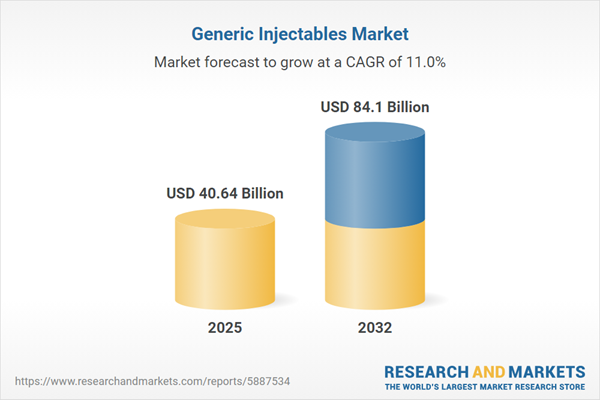Speak directly to the analyst to clarify any post sales queries you may have.
The Generic Injectables Market is undergoing significant transformation, reshaping access to critical therapies while driving operational efficiencies across the global healthcare sector. As evolving treatment demands meet breakthroughs in formulation, manufacturing, and distribution, stakeholders must align with new trends that impact both cost and care quality.
Market Snapshot: Growth and Opportunity in the Generic Injectables Market
The Generic Injectables Market grew from USD 36.58 billion in 2024 to USD 40.64 billion in 2025. It is expected to continue growing at a CAGR of 10.96%, reaching USD 84.10 billion by 2032. Demand is being fueled by healthcare expenditure pressures, patent expirations, and an increased focus on accessible treatments across diverse global regions. Improvements in regulatory efficiency and technological advances are driving expansion in both established and emerging markets.
Scope & Segmentation: Defining the Generic Injectables Landscape
- Distribution Channels: Direct tender, hospital pharmacy distribution, online (B2C platforms, e-pharmacies), and retail distribution.
- Dosage Forms: Emulsion, lyophilized powder, solution, and suspension.
- Drug Classes: Analgesics, anesthetics, antibiotics (aminoglycosides, beta-lactams, glycopeptides), cardiovascular agents, oncology agents (cytotoxics, monoclonal antibodies).
- End Users: Ambulatory surgical centers, clinics (community and specialty), hospital pharmacies, retail pharmacies.
- Large Volume Parenteral Containers: Bags and bottles.
- Molecule Portfolio: Cefuroxime, fentanyl, meropenem, oxaliplatin, vancomycin.
- Packaging Types: Ampoules, cartridges, pre-filled syringes (safety, standard), vials.
- Product Formats: Ampoule, vial, pre-filled syringe (safety, standard).
- Administration Routes: Intramuscular, intravenous, subcutaneous.
- Therapeutic Applications: Anesthesia, anti-infective (antibiotics, antivirals), cardiovascular, oncology (cytotoxic agents, targeted therapies), pain management (non-opioids, opioids).
- Regions: Americas (North America, Latin America), Europe, Middle East & Africa, and Asia-Pacific, with specific coverage of leading healthcare and pharmaceutical markets.
- Profiled Companies: Fresenius Kabi AG, Baxter International Inc., Pfizer Inc., Sandoz International GmbH, Teva Pharmaceutical Industries Limited, Hikma Pharmaceuticals PLC, Viatris Inc., Amneal Pharmaceuticals Inc., Aspen Pharmacare Holdings Limited, and Recipharm AB.
Key Takeaways for Decision-Makers
- The generic injectables market supports healthcare system resiliency by broadening access to vital treatments for chronic and acute illnesses.
- Continuous manufacturing and advanced supply chain orchestration are raising the bar for product quality and responsiveness.
- Pharmaceutical manufacturers are adopting new packaging and administration formats—including safety-engineered pre-filled syringes—to improve patient safety and facilitate hospital-to-home transitions.
- Cross-border regulatory harmonization is streamlining market entry while fostering investment in compliance and nearshore manufacturing strategies.
- Strategic alliances, digital logistics, and sustainable production practices are now mission-critical for product differentiation and margin protection.
Tariff Impact: Navigating Regulatory and Supply Chain Shifts
Recent United States tariff regulations are influencing sourcing strategies, with manufacturers diversifying supply chains and investing in local capacity to mitigate cost volatility. This has prompted the development of alternative procurement approaches and reinforced collaboration between producers, regulators, and trade authorities. Proactive initiatives include expanded inventory buffers, process optimization, and efforts to achieve exemptions, all with the goal of maintaining service continuity and stable pricing for healthcare providers.
Methodology & Data Sources
This market analysis uses both primary and secondary research approaches. Expert interviews, structured surveys with industry stakeholders, and thorough reviews of regulatory filings and proprietary databases underpin the findings. Each data point has been cross-validated and reviewed by a panel of domain specialists to ensure accuracy and relevance across all strategic dimensions.
Why This Report Matters
- Enables senior executives to identify emerging opportunities for operational efficiency and cost control within the generic injectables sector.
- Offers actionable insights on regional demand trends, regulatory compliance, and technology adoption supporting timely strategic decisions.
- Equips leadership teams to optimize supply chain and portfolio strategies in a fast-evolving and regulated environment.
Conclusion
Innovation, operational agility, and informed investment remain essential for sustained success in the generic injectables market. This report empowers stakeholders to navigate shifting regulatory, supply, and technology landscapes—securing both competitive advantage and improved patient access.
Additional Product Information:
- Purchase of this report includes 1 year online access with quarterly updates.
- This report can be updated on request. Please contact our Customer Experience team using the Ask a Question widget on our website.
Table of Contents
3. Executive Summary
4. Market Overview
7. Cumulative Impact of Artificial Intelligence 2025
Companies Mentioned
The companies profiled in this Generic Injectables market report include:- Fresenius Kabi AG
- Baxter International Inc.
- Pfizer Inc.
- Sandoz International GmbH
- Teva Pharmaceutical Industries Limited
- Hikma Pharmaceuticals PLC
- Viatris Inc.
- Amneal Pharmaceuticals Inc.
- Aspen Pharmacare Holdings Limited
- Recipharm AB
Table Information
| Report Attribute | Details |
|---|---|
| No. of Pages | 191 |
| Published | October 2025 |
| Forecast Period | 2025 - 2032 |
| Estimated Market Value ( USD | $ 40.64 Billion |
| Forecasted Market Value ( USD | $ 84.1 Billion |
| Compound Annual Growth Rate | 10.9% |
| Regions Covered | Global |
| No. of Companies Mentioned | 11 |









